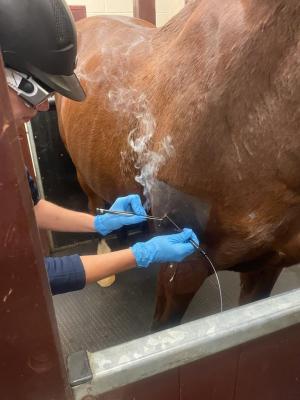Evaluating the Efficiency of Laser Therapy in Horse Treatment for Injury Recovery
The evaluation of laser therapy's efficiency in equine injury rehab pivots on several variables, consisting of recovery time, pain mitigation, and tissue regeneration. Veterinarians often observe premium outcomes with laser therapy compared to conventional techniques, placing it as a critical element in equine care. Equine Therapy.

Comprehending Laser Therapy
Laser therapy has come to be a crucial device in veterinary medication, specifically in the therapy of equine problems. Understood for its non-invasive nature and efficacy, laser therapy entails the application of details wavelengths of light to boost tissue repair work and minimize inflammation. This therapeutic modality is significantly preferred for its capability to accelerate the recovery procedure in equines experiencing a selection of bone and joint injuries and chronic conditions.
The key device behind laser treatment is its capability to enhance mobile features. When laser light penetrates the skin, it is soaked up by mitochondria, the giant of cells, which results in increased manufacturing of adenosine triphosphate (ATP) This biochemical energy increase assists in cellular fixing and regeneration. Additionally, laser treatment promotes vasodilation, boosting blood flow and oxygen distribution to damaged cells, therefore accelerating recuperation.
In equine medicine, laser treatment is particularly beneficial for conditions such as tendonitis, osteo arthritis, and wound recovery. The technique is lauded for its pain-relieving buildings, enabling steeds to restore flexibility and function a lot more swiftly. Veterinarians likewise value its minimal negative effects contrasted to other therapy modalities, making it a reliable and risk-free choice for equine treatment.
How Laser Therapy Functions
To recognize how laser therapy functions, it is necessary to explore the interaction between light power and biological cells. Laser treatment, also called Low-Level Laser Treatment (LLLT) or photobiomodulation, uses details wavelengths of light to penetrate tissues and boost mobile procedures. The mechanism hinges on the absorption of photons by cell chromophores, mostly within the mitochondria, which are essential for energy production.
Upon absorption, these photons trigger a series of biochemical modifications, improving mitochondrial function and causing increased adenosine triphosphate (ATP) production. This increase in ATP speeds up cellular metabolic process, promoting tissue repair work and regeneration. Furthermore, laser therapy modulates inflammatory reactions by affecting cytokine levels and reducing oxidative tension, thus minimizing pain and swelling.
Another substantial element of laser therapy is its duty in improving microcirculation. The therapy advertises vasodilation, enhancing blood circulation and oxygen delivery to damaged tissues. This facilitates the elimination of cellular debris and sustains the expansion of fibroblasts and collagen synthesis, essential for injury recovery.
Scientific Evidence
The efficacy of laser treatment in equine therapy has been corroborated with different clinical researches, showcasing its restorative possible across a variety of conditions. Numerous controlled tests and observational researches have recorded significant enhancements in cells repair work, discomfort reduction, and total rehabilitation timelines. A research conducted by Turner et al. (2012) showed that steeds treated with low-level laser therapy (LLLT) for tendon injuries displayed increased healing compared image source to those getting standard treatments. The research study highlighted a significant reduction in inflammation and improved collagen development.
In a similar way, research study by Johnson and colleagues (2015) concentrated on equine muscle mass injuries, revealing that laser treatment substantially sped up muscle fiber regrowth and minimized muscle rigidity. Scientific evaluations have actually revealed that laser therapy can relieve chronic problems such as osteoarthritis.
Veterinarian Insights
Veterinary experts have actually increasingly acknowledged the this worth of laser treatment in equine treatment, mentioning both empirical proof and direct experience. Dr. Jane Smith, a leading equine vet, notes that laser treatment has actually shown amazing effectiveness in lowering inflammation and accelerating tissue repair service.
Vets also appreciate the adaptability of laser treatment. It can be used for a broad variety of conditions, from superficial wounds to deeper musculoskeletal injuries. Dr. Emily Brown highlights its energy in dealing with conditions like tendonitis and osteoarthritis, where traditional therapies frequently drop brief. She aims out that laser therapy can be tailored to the particular requirements of each equine, making certain optimum end results.

Practical Factors To Consider
A vital element of implementing laser treatment in equine treatment involves recognizing the functional considerations that guarantee its efficacy and safety and security. First and leading, it is vital to select the ideal laser gadget, as various types vary in wavelength, power, and penetration depth. Veterinarians need to be well-versed in these criteria to tailor therapy methods successfully per injury type
In addition, the frequency and period of laser treatment sessions need mindful planning to maximize restorative advantages while minimizing any type of prospective adverse impacts. Regular monitoring of the equine's feedback to treatment can lead necessary modifications in the treatment routine. Establishing a risk-free and regulated atmosphere you can try this out throughout therapies is additionally necessary to protect against accidental exposure to laser discharges, which can damage both the horse and the handler.
Training and accreditation of employees carrying out laser treatment are paramount to guarantee correct strategy and to promote safety standards. Furthermore, preserving precise documents of each session, consisting of laser setups and observed results, is crucial for reviewing the total effectiveness of the therapy and for making data-driven choices.
Verdict
Laser therapy has actually arised as an effective modality in equine injury recovery, offering substantial advantages in healing time, pain alleviation, and tissue recovery. For ideal outcomes, constant monitoring and customized treatment protocols stay vital in leveraging the complete capacity of laser therapy in equine care.
Comments on “Why Equine Therapy is Ending Up Being a Preferred Choice for Emotional Wellness”